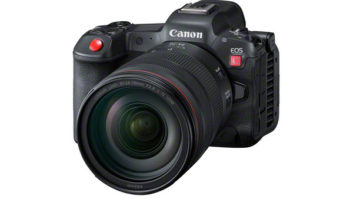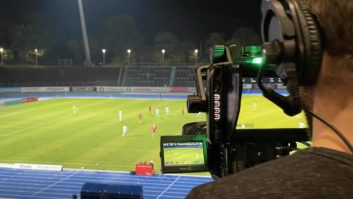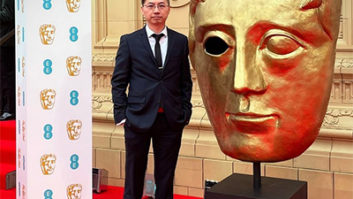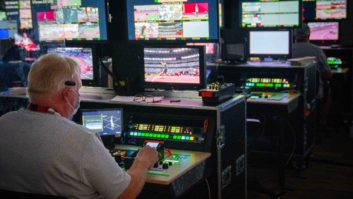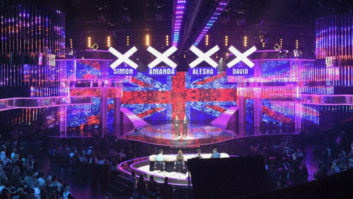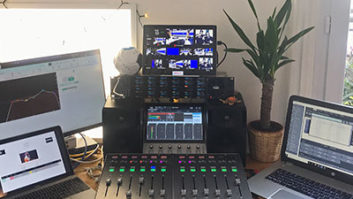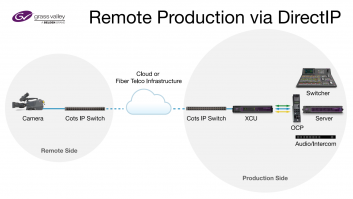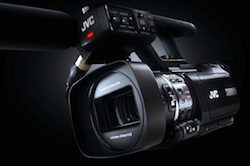
Sony has joined Panasonic in offering professional AVCHD camcorders recording to low-cost solid-state media. David Fox reviews the options.
The prototype NXCAM revealed by Sony last month is essentially a remodelling of its HVR-Z5E with a new recording system. This replaces the Z5’s HDV tape drive and add-on Compact Flash card recorder with two Memory Stick slots and an add-on solid-state drive, recording 24Mbps AVCHD. It is intended to be first of a new, low-cost solid-state line-up, with the first cameras shipping sometime in the first half of 2010.
AVCHD (which uses an MPEG-4 AVC/H.264 Long-GoP codec), is widely used in consumer camcorders (almost always at lower bitrates) and is supported natively by some nonlinear edit systems (such as Edius, Vegas and Premiere), but not yet by Apple and Avid, where transcoding is necessary — which will probably diminish its appeal to many broadcasters initially.
It will cost about the same price as the Z5, and will address one problem professionals have with AVCHD, its AC3 audio codec. Although this will still be included, the NXCAM will also add two-channel linear PCM audio to be meet broadcast expectations.
The optional 128GB Flash memory drive will be especially appealing to anyone shooting observational documentaries or to wedding videographers, who need long recording times, as it will store up to 11 hours at maximum quality (and will cost less than Eur1,000). Users will be able to record on to it and the Memory Sticks at the same time. Memory Sticks currently come in sizes up to 32GB (costing less than a quarter of the price of Sony’s new lower-priced SxS-1 cards) and the NXCAM will automatically record on the second one once the first is full.
The camera includes a GPS receiver for the first time on a professional Sony camcorder, recording the metadata in the AVCHD stream. This could be useful for future applications, whether offering a map-driven interface to online video, for retrieving archives, or for researchers shooting a recce. It will also have HD-SDI output for the first time on a compact Sony camcorder.
AVCHD on SD
Panasonic’s latest low-cost professional camcorder is the AG-HMC41E, which records AVCHD to SD memory cards. It is being offered with a copy of Edius Neo 2 editing software (until March) for Eur2,470.
“This camcorder demonstrates Panasonic’s commitment to making tapeless technology as accessible as possible to the broadest cross-section of professional users and our bundled software offering effectively lowers the cost of entry even further. For a minimum outlay, users can now experience the many workflow benefits that recording directly to SD and SDHC cards bring,” said Nela Pertl, market intelligence manager at Panasonic Broadcast and IT Systems.
The AG-HMC41E can record up to 180 minutes of HD at 1920×1080 on a 32GB SDHC card at 24Mbps. It has: three 1/4.1-inch progressive MOS sensors with a total of 3.05 million pixels; a 12x Leica zoom lens; weighs less than 1kg; and captures still images at 10.6 megapixels. It includes various focus-assist functions, such as facial recognition and touch-type auto-focusing, as well as professional functions, such as waveform monitoring. Accessories include a removable grip and an optional removable XLR microphone adaptor.
FCP native
An easy workflow is one of the key attractions of JVC’s lightweight, shoulder-mounted GY-HM700 camcorder and its tiny GY-HM100. Both can record Final Cut Pro-compatible .MOV (QuickTime) files direct to cheap SDHC cards (or Sony XDCAM EX-compatible .MP4 files for other NLEs). The GY-HM700 can also record to SxS cards using an optional drive (while simultaneously recording to the SD card).
The HM700, which started shipping in March, gained the more flexible recording as part of a recent upgrade, which also gave it a more powerful built-in DNR, producing higher picture quality.
Both cameras record full 1920×1080 at up to 35Mbps, as well as 720p (19/35Mbps) and 1080i (25Mbps HDV) in SP mode. At 35Mbps, two 32GB SD cards can record for up to six hours, while the cost per minute is about the same as tape, making it economical enough to be used for archiving. The HM700 has three 1/3-inch CCDs, a 14x Canon lens (interchangeable), and HD-SDI output. The HM100 has three 1/4-inch CCDs, a fixed Fujinon 10:1 zoom, manual controls, and HDMI output.
Standard Def returns
Sony’s new PMW-EX1R, a revised version of the EX1, adds a number of features requested by users, including: an HDMI output; a higher-resolution viewfinder; an improved LCD screen; one-push Auto Iris; an improved hand grip; one-click S&Q mode (Slow and Quick); an image inversion option (if working with 35mm lens adaptors); and up to 15 second picture cache recording.
The EX1R has also been upgraded by downgrading – having added standard definition to its recording options. This is because “a lot of people on the market were asking for it,” particularly in Eastern Europe, the Middle East and Africa, explained Olivier Bovis, general manager product marketing.
Indeed, Sony recently launched its first SD-only model in a long time, recording to tape. The new DSR-PD175P is essentially a direct replacement for the popular PD170.
“From wedding and event videography, through to corporate TV production and right up to broadcast documentary production and newsgathering, the DSR-PD175P is the perfect tool for standard definition production,” claimed Bill Drummond, senior product marketing manager, Sony Europe. “There is continuing demand for high quality DVCAM production tools in many of our markets and the DSR-PD175P has been developed specifically to respond to these important customers’ needs.”
The PD170 was renowned for its low-light capability (1 lux), but its successor isn’t quite as effective in the dark, although it isn’t far off it at 1.5 lux. It does have the advantage of being 16:9 native and uses three of the same 1/3-inch Exmor ClearVid CMOS sensors found in the Z5.
The camera has a fixed 20x Sony G lens, three ND filters and independent focus, zoom and iris rings. It also has an improved high resolution LCD panel and viewfinder. To aid migration from the PD170, the PD175 also uses L series batteries, removing the need to buy new battery systems (unlike most of Sony’s HDV cameras).
It can also record to flash memory, by plugging in the HVR-MRC1K Compact Flash solid state recorder, and adds a 25p progressive scan mode for a filmic look. The 25p image is recorded as an interlaced signal in two fields, for compatibility with editing and monitoring equipment that accept interlaced signals, but maintains the quality of the 25p image.
